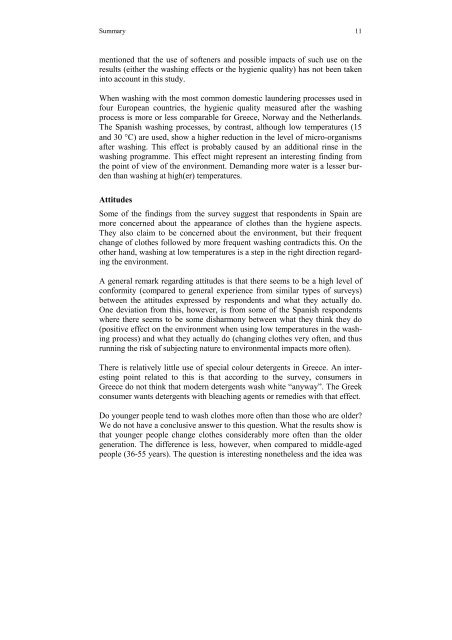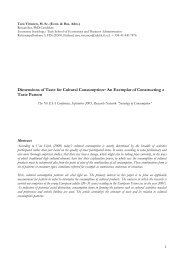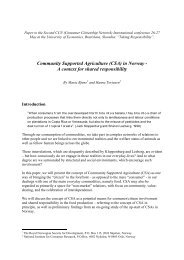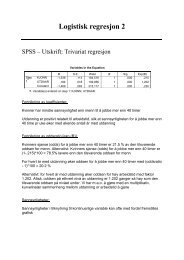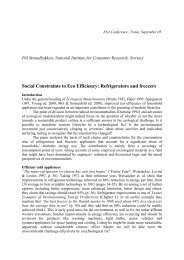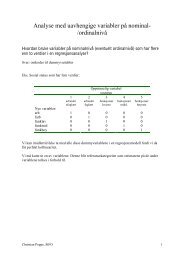an investigation of domestic laundry in europe - habits ... - SIFO
an investigation of domestic laundry in europe - habits ... - SIFO
an investigation of domestic laundry in europe - habits ... - SIFO
Create successful ePaper yourself
Turn your PDF publications into a flip-book with our unique Google optimized e-Paper software.
Summary 11mentioned that the use <strong>of</strong> s<strong>of</strong>teners <strong>an</strong>d possible impacts <strong>of</strong> such use on theresults (either the wash<strong>in</strong>g effects or the hygienic quality) has not been taken<strong>in</strong>to account <strong>in</strong> this study.When wash<strong>in</strong>g with the most common <strong>domestic</strong> launder<strong>in</strong>g processes used <strong>in</strong>four Europe<strong>an</strong> countries, the hygienic quality measured after the wash<strong>in</strong>gprocess is more or less comparable for Greece, Norway <strong>an</strong>d the Netherl<strong>an</strong>ds.The Sp<strong>an</strong>ish wash<strong>in</strong>g processes, by contrast, although low temperatures (15<strong>an</strong>d 30 °C) are used, show a higher reduction <strong>in</strong> the level <strong>of</strong> micro-org<strong>an</strong>ismsafter wash<strong>in</strong>g. This effect is probably caused by <strong>an</strong> additional r<strong>in</strong>se <strong>in</strong> thewash<strong>in</strong>g programme. This effect might represent <strong>an</strong> <strong>in</strong>terest<strong>in</strong>g f<strong>in</strong>d<strong>in</strong>g fromthe po<strong>in</strong>t <strong>of</strong> view <strong>of</strong> the environment. Dem<strong>an</strong>d<strong>in</strong>g more water is a lesser burdenth<strong>an</strong> wash<strong>in</strong>g at high(er) temperatures.AttitudesSome <strong>of</strong> the f<strong>in</strong>d<strong>in</strong>gs from the survey suggest that respondents <strong>in</strong> Spa<strong>in</strong> aremore concerned about the appear<strong>an</strong>ce <strong>of</strong> clothes th<strong>an</strong> the hygiene aspects.They also claim to be concerned about the environment, but their frequentch<strong>an</strong>ge <strong>of</strong> clothes followed by more frequent wash<strong>in</strong>g contradicts this. On theother h<strong>an</strong>d, wash<strong>in</strong>g at low temperatures is a step <strong>in</strong> the right direction regard<strong>in</strong>gthe environment.A general remark regard<strong>in</strong>g attitudes is that there seems to be a high level <strong>of</strong>conformity (compared to general experience from similar types <strong>of</strong> surveys)between the attitudes expressed by respondents <strong>an</strong>d what they actually do.One deviation from this, however, is from some <strong>of</strong> the Sp<strong>an</strong>ish respondentswhere there seems to be some disharmony between what they th<strong>in</strong>k they do(positive effect on the environment when us<strong>in</strong>g low temperatures <strong>in</strong> the wash<strong>in</strong>gprocess) <strong>an</strong>d what they actually do (ch<strong>an</strong>g<strong>in</strong>g clothes very <strong>of</strong>ten, <strong>an</strong>d thusrunn<strong>in</strong>g the risk <strong>of</strong> subject<strong>in</strong>g nature to environmental impacts more <strong>of</strong>ten).There is relatively little use <strong>of</strong> special colour detergents <strong>in</strong> Greece. An <strong>in</strong>terest<strong>in</strong>gpo<strong>in</strong>t related to this is that accord<strong>in</strong>g to the survey, consumers <strong>in</strong>Greece do not th<strong>in</strong>k that modern detergents wash white “<strong>an</strong>yway”. The Greekconsumer w<strong>an</strong>ts detergents with bleach<strong>in</strong>g agents or remedies with that effect.Do younger people tend to wash clothes more <strong>of</strong>ten th<strong>an</strong> those who are older?We do not have a conclusive <strong>an</strong>swer to this question. What the results show isthat younger people ch<strong>an</strong>ge clothes considerably more <strong>of</strong>ten th<strong>an</strong> the oldergeneration. The difference is less, however, when compared to middle-agedpeople (36-55 years). The question is <strong>in</strong>terest<strong>in</strong>g nonetheless <strong>an</strong>d the idea was


